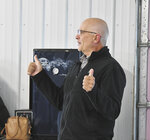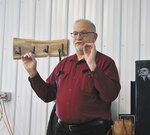

LEWISTON, Minn. — Farmers and conservation professionals gathered Nov. 27, 2023, for a field day event planned by the Driftless Area Ag Alliance.
The Driftless Area Ag Alliance, which hosted the field day, is a farmer-operated conservation nonprofit with several dairy farmers on its volunteer board.
Rita Young serves as president of the alliance.
“We want to work to build incentive programs to encourage farmers to try new practices,” Young said. “We want to count on science to help farmers understand the issues with the environment and to identify a solution and to also measure our progress.”
The field day focused on cover crops and conservation, with a demonstration by Daley Farm of Lewiston and presentations by industry experts.
Advice was given on how farmers can take advantage of federal, state and local programs. A recent petition to the U.S. Environmental Protection Agency concerning nitrate contamination in drinking water was also discussed.
The event was hosted on Shelly DePestel’s farm near Lewiston, which is part of Daley Farm of Lewiston.
Ben Daley shared their farm’s cover crop journey. The Daleys have 1,000 acres of cover crops as well as 900 acres of alfalfa and 300 acres of pasture. Daley said over 80% of their ground has been covered with a crop year-round for the past 10 years.
This fall, 65 pounds of rye seed was applied after corn silage had been harvested the second weekend of September. The Daleys then applied manure, and within four days, the rye had sprouted.
“It reacts really well with ... that little bounce of moisture with manure,” Daley said.
The Daleys terminate their cover crops and do not harvest them for feed. Daley said they have found that allowing the rye to grow 1 foot tall in the spring is too late to harvest due to the amount of plant mass.
Dave Jones, the state conservation engineer with the U.S. Department of Agriculture Natural Resources Conservation Service, spoke on conservation programs available to farmers through the NRCS.
Jones said $35 million in conservation was installed on land in Minnesota through the Environmental Quality Incentives Program this past year and another $33 million was installed through the Conservation Stewardship Program.
Jones said more funds will be allotted for these two programs in 2024, with $50 million designated for EQIP and a little more than $37 million for CSP. A significant portion will come through the Inflation Reduction Act.
“Soon we’ll be able to say money’s not the problem; it’s going to be the capacity of what can we do together,” Jones said.
A program that Jones said has not gained traction is the Conservation Effects Assessment Project. The program helps monitor environmental progress after a conservation practice is added.
In 2023, the state celebrated 1 million acres of land enrolled in the Minnesota Agricultural Water Quality Certification Program. Jones said he is surprised that all farms are not part of the free evaluation. If a farm does not meet the criteria, conservation recommendations may be provided.
“You might be surprised and find out ... you’re already at that threshold,” Jones said. “Congratulations, you’re ag water quality certified, and you’ve got 10 years of regulatory certainty.”
Jones said the No. 1 job for NRCS employees is to listen to farmers’ needs.
“What kind of problems do you have? What would you like to see for outcomes and goals?” Jones said.
Leah Ellman-Stortz, a soil conservationist for the Lewiston NRCS field office, agreed.
Ellman-Stortz said when talking to a farmer about cover crops, the office starts by asking questions about resource concerns.
“Do you have erosion going on out there?” Ellman-Stortz said. “Are you worried about compaction? Are there any other resource concerns that we could potentially address? Is cover cropping the only thing that you would want to do?”
Ellman-Stortz said EQIP and CSP are the two programs she primarily works with. She said CSP is a good fit for farmers who have already done conservation practices on their land.
“The purpose is to enroll all of that land and to enhance whatever conservation is on it already,” Ellman-Stortz said. “It can be a little bit difficult to get into, but it is a very good program.”
Ellman-Stortz said EQIP is a better program to try something new, such as cover crops, since it does not have acreage requirements for minimums or maximums.
“The goal is to really target a resource concern to get you to try something that may be new or that you may have been wanting to do for a while but just don’t have the funds to do,” Ellman-Stortz said.
Another speaker at the event was Warren Formo, executive director of the Minnesota Agricultural Water Resource Center. Formo’s main presentation centered around a petition filed in April 2023 with the U.S. EPA regarding safe drinking water for the karst region of southeast Minnesota.
Formo said the petition filed by 11 environmental groups asks the EPA to step in using the Safe Drinking Water Act. The EPA would take measures where the Minnesota Department of Health, Minnesota Department of Agriculture and the Minnesota Pollution Control Agency have failed to act.
Petition recommendations prohibit concentrated animal feeding operations from “opening, expanding or modifying operations in the karst region unless and until nitrate concentrations in wells with historically high levels ... fall below the maximum contaminant limit of 10 mg/L.”
The petition also addresses the application of nitrogen and manure.
The petition cites that testing done on wells in the karst region has shown varying percentages of wells with unsafe levels of nitrate contamination.
The EPA responded to the petition in November 2023. According to the EPA website, the state should develop a plan and provide education and outreach as well as alternative drinking water to residents with water above the maximum contaminant level for nitrate.
Formo said cover crops are a practice that can make a difference in nitrate levels and that good nutrient management will be a foundational management practice.
“There’s a good chance ... that we can remove (a percentage) of this nitrogen (through cover crops),” Formo said. “The best news is we keep it in the rooting zone for next year’s crop.”
Formo said with money available through various avenues for conservation practices, this is a good time to think about trying something.
“It’d be great if we as an industry can come and say, ‘Hey, we have some solutions ourselves,’” Formo said. “‘We’ve thought (them) out. Scientifically, they make sense. We need some resources.’ ... Inflation Reduction Act could be a place (for) this more generic conservation planning.”
Comments
No comments on this item Please log in to comment by clicking here